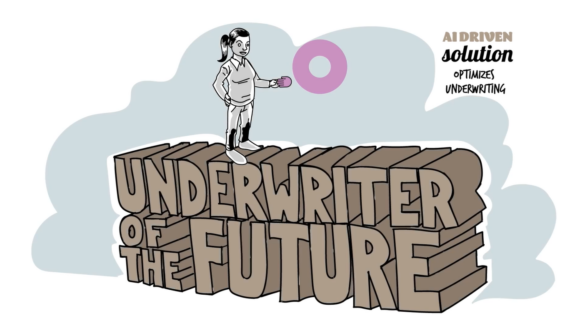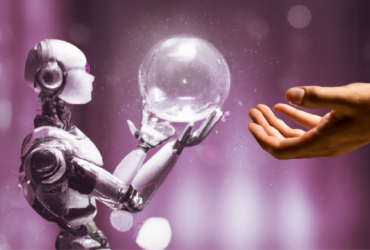Augmentation, the Alliance of an Era

The term “Artificial Intelligence” or AI, has been branded as both the answer to every businesses’ prayers and the downfall of our civilization. And as with most things, the truth lies somewhere in between both extremes.
Artificial intelligence is simply machine-based intelligence. Humans and animals use natural intelligence which turns out to be our brains and central nervous systems, working together. Computer-based artificial intelligence can streamline thousands of different business processes in a fraction of the time it takes a person to complete the same tasks. Think of artificial intelligence simply as a tool companies use to improve efficiency in computing and data processing.
Artificial intelligence doesn’t involve will, consciousness, or a sense of self. It relies on simple binary code (yes/no, zero/one, good/bad) to enable a decision to be made. A “smart” thermometer in your home can be set to change the temperature depending on the time of day. It may seem ”smart” that the temperature is lowered at night, but the system is simply reacting to a data input that says at 10 pm, lower the temperature to 70 from 65 degrees. What the thermometer can’t do is see you shivering and automatically raise the temperature from 70 to 65 degrees to ensure you’re comfortable.
So, think of artificial intelligence as simply a way to complete basic tasks or processes quickly and accurately. But be careful, AI is not the universal solution to every problem, process, and data point. What it does, it does extremely well, but we still need people to write algorithms or instructions for it, and human brains are required to ensure some processes meet operational goals.
To use the Insurance sector as an example, augmentation swiftly creates what we like to call underwriters of the future!

What about Machine Learning?
Machine learning is a specific type of artificial intelligence. It involves software applications that adapt to the data presented to provide more accurate outcomes without requiring explicit programming. Machine learning takes historic data to extrapolate a new predictive data output.
Let’s revisit the example of the smart thermometer to help explain our point. Artificial intelligence tells the machine to lower the temperature at night. Machine learning takes the data collected by the device to know that specific times of year require more heat (winter) and which months require air conditioning to keep a home cool. It also knows that night comes earlier in the winter than summer. It can’t react to environmental influences automatically or change the temperature to accommodate an unseasonably warm day (yet).
Industry uses machine learning to better predict trends in both client behavior as well as operational patterns the business develops. Machine learning is the technology behind chatbots for example. They use historical data to find solutions to problems. If you are having trouble with a website’s functionality and use the chatbot to ask questions, the chatbot will pull data via keywords and provide solutions to the visitor’s issue. Machine learning chatbots also know when bringing in a human to solve an issue is necessary. This ensures better customer service using fewer staff members, and a more beneficial outcome for both person and company.
Basic AI
Let’s focus on how thinktum uses artificial intelligence as part of our solution for the insurance industry. We’ll begin with an overview of how the industry works without AI then explain what we do and how it impacts both the insurer and the potential policyholder, for instance.
We begin with Tom and Mary. Tom is a 35-year-old father of two that has recently decided he needs life insurance. Mary is an insurance underwriter at her firm. Her job is to vet applications, assess each for risk, check supporting documentation to ensure it aligns with the policy guidelines, then check for fraud, and finally approve or deny the application.
For Tom to be sold a life insurance policy, the insurer must decide whether to insure him or not based on a set of parameters and risk matrices. He may say in the application that he is in good health but supporting documents may indicate he is slightly overweight, have hypertension, or presents other chronic health conditions. Risks must be considered carefully, and Mary the underwriter must decide whether the risks outweigh the company benefit of selling the policy.
thinktum’s Pure no-code solutions work between Mary and Tom, assessing Tom’s application and documentation to provide a real-time decision-recommendation on whether to provide a policy or not. The system has been designed to weigh risk in a fraction of the time it takes a person. This allows Mary to work on more complicated applications or tasks that require an extra layer of human-based attention or decision-making. Tom gets insured while Mary makes headway on other crucial tasks, and Tom’s entire process took seconds instead of hours or days, from application to policy issue.
Think of artificial intelligence as a tool that can smash through enormous piles of data, extrapolating information. That’s namely why it is so valuable to the insurance market. Alternatively, AI removes any inherent bias held by humans to render verdicts based strictly on data. Prospective and current insurance policyholders don’t care how a decision is made, as long as it comes back quickly and, most of all is decided fairly.

A primer on Augmentation
At thinktum, we define augmentation as the partnership developed between artificial intelligence and humans. Many refer to it as human-assisted AI. We would argue that it is not. It is human-steered AI. Human minds are complex and astonishing, but they also require rest or can be negatively affected by many different factors, including fatigue, external stimuli, or emotions. Augmentation is a collaboration or a partnership and without humans, AI is simply another tool, like a hammer. It’s useful but needs a human hand to hold it for it to work. Read more on the subject with Augmentation and liz assess – a powerful marriage of form and function.
The insurance industry is the perfect solution vehicle for augmentation. Vast amounts of very personal data are used to better understand the role of risk in the industry. That risk runs through every transaction an insurance provider takes with a client. What augmentation does is manage that risk in a way that is robust, accurate, and financially beneficial for the provider; but also, better for the client since more people can be insured. This is a win-win for everyone.
Transitioning to the fifth Industrial Revolution (5IR)
An industrial revolution occurs when technology advances enough to become ubiquitous and changes how we live and work. The first revolutions occurred when the traditional agrarian (land-based agriculture) societies were transformed by the development and use of mechanized manufacturing, large-scale industry, and factories. Suddenly goods were being manufactured quickly, workers lined up to participate in the new economy, and mechanized labor was born.
With each new industrial revolution, huge technological strides were made, a larger variety of goods were produced, and the way we work adapted to harness each new leap. In fact, with every revolution, there have been new technologies invented and developed; and each brings a change in production because of that technology.
There have been four previous Industrial Revolutions:
- The first Industrial Revolution (1IR) occurred when steam engines replaced humans and horsepower in an agricultural society. Think of this as the era of mechanization.
- The second, or 2IR, brought about the production of steel, electricity, and the invention of the combustion engine. Consider this the era of electrification.
- The third IR brought us into the age of computing and included the inventions of computers, digitization, and the Internet. This is the era of automation, but also globalization.
- The fourth IR began just at the turn of the 21st century and involves the next iteration of computing, including: The Internet of Things (IoT), robotics, cryptocurrencies, augmented and virtual realities, and blockchain. This is the era of digitization.
The fifth Industrial Revolution is upon us now. The 5IR is bringing about a time of humans and technology working together. This includes machine learning and artificial intelligence. Finally, human-derived intentions such as purpose, innovation, and inclusivity mesh with technology to produce computing systems for the good of humankind. This is the time of personalization. Learn about the value of tailor-made journeys with Hyper-personalization paves the road to success.
It’s a mistake to think that 5IR is built on a foundation of pure altruism, however; industry and manufacturing are more successful than ever, but this revolution is based rather on humans using technology to better humanity.
But how does artificial intelligence help humanity? First, it seamlessly completes tasks that are onerous for the human brain. Going back to our example of Tom and Mary, there are just so many life insurance applications that Mary can effectively consider in a day. And since she doesn’t work 24/7, there are times when data is just sitting there, waiting for Mary to turn on her computer. Artificial intelligence doesn’t require time off, doesn’t take sick days, and can work 24/7/365.
As noted previously, this allows Mary to spend her days on other problems, situations, and opportunities for her clients, her company, and herself. Her work is more interesting since much of the rote, busy work has been eliminated, leaving her to spend time on client files that are intricate, complicated, or time-consuming; even better, she can now take on new responsibilities and broaden her value in the company. Mary is more engaged with her tasks and finds her happiness quotient increasing at work; her career/life balance improves, along with her performance.
Here’s a short video depicting this partnership with Life Insurance as a use case.
Don’t miss out
This is the power of artificial intelligence. In the same way our ancestors used tools to grow crops and farm food, we’re now using technological tools to farm data to improve lives around the world. Artificial intelligence will power and enable huge leaps in new developing technologies. We’ll also see more AI being used in all kinds of different sectors, including healthcare, national security, finance, criminal justice, and transportation.
Artificial intelligence will continue to enable industries, companies, and workers the ability to do more in less time. It will enable humans to do what they do best, think. With each industrial revolution, workers around the globe have been released from the traditional demands of physical work to more intellectual pursuits, where we have zero rivals. Human thought and ambition will act as an accelerant in the years to come. Humans will devise new ways of working and through augmentation, many additional sectors will incorporate human/machine interfaces but with the goal of making human life healthier, more rewarding, and kinder to the billions of us sharing our small, blue marble in space.
If you are interested in learning more about augmentation, artificial intelligence, or how thinktum can revolutionize the use of data for your business and clientele, reach out to us today. You’ll be amazed at how easy it is to get started. The 5IR is here: augmentation is the alliance of an era.
Don’t miss out.
Book some time with us to find out more today!


